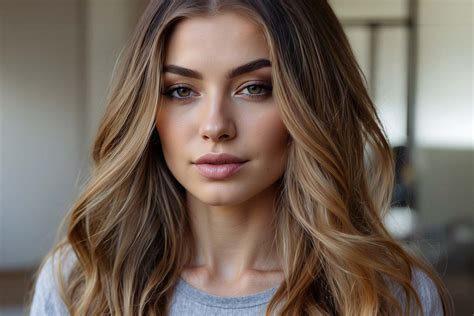Blonde hair captivates with its elegance and radiance. Adding lowlights to this radiant base can enhance its beauty even further, creating a captivating multi-dimensional effect. Lowlights are strategically placed darker strands that add depth, warmth, and subtle contrast to blonde hair, elevating its style and making it effortlessly alluring.

Benefits of Lowlights in Blonde Hair
-
Dimension and Texture: Lowlights break up the uniformity of blonde hair, creating the illusion of depth and texture. This visual interest adds a touch of sophistication and volume, making thin or flat hair appear thicker and fuller.
-
Warmth and Contrast: Lowlights introduce warmer tones to blonde hair, counteracting the sometimes cool or ashy appearance of natural blonde. The contrast between the light and dark strands enhances the hair’s overall vibrancy and prevents it from looking one-dimensional.
-
Personalized Style: Lowlights allow for tailored hair color that complements your skin tone and facial features. Whether you prefer subtle highlights that seamlessly blend in or bold, contrasting lowlights that add a dramatic touch, there’s a lowlight option to suit every taste.
Choosing the Right Lowlight Color
The key to successful lowlights lies in selecting a color that harmonizes with your blonde hair and enhances your overall look. Here’s how to choose the perfect shade:
-
Consider Your Skin Tone: Warm skin tones suit golden or caramel-colored lowlights, while cool skin tones complement ash or beige lowlights.
-
Match the Level of Blonde: For natural blonde hair, lowlights should be around 2-3 levels darker than your base color. For bleached blonde hair, you may choose lowlights 3-5 levels darker to create more noticeable contrast.
-
Personal Preference: Ultimately, the choice of lowlight color is a matter of personal preference. If you’re unsure, consult with a professional colorist who can assess your hair and recommend the most flattering shade for you.
Tips for Lowlighting Blonde Hair
-
Use a High-Quality Hair Colorant: Invest in professional-grade hair color that minimizes damage and provides vibrant, long-lasting results.
-
Apply to Dry, Clean Hair: Lowlights should be applied to freshly washed, towel-dried hair to ensure even distribution and optimal color absorption.
-
Section Your Hair: Divide your hair into sections using clips or hairbands. This will make the highlighting process easier and prevent streaks or uneven results.
-
Choose a Fine-Toothed Comb: Use a fine-toothed comb to apply the colorant to small sections of hair, starting from the root and working your way down.
-
Process for the Recommended Time: Follow the manufacturer’s instructions carefully regarding the processing time. Over-processing can damage your hair, while under-processing may result in insufficient color deposit.
-
Use a Toner: After rinsing and conditioning your hair, apply a toner to enhance the color and create a more polished look.
Step-by-Step Approach to Lowlighting Blonde Hair
- Gather Materials: Hair colorant, developer, hair clips, mixing bowl, brush, fine-toothed comb, gloves, and towels.
- Prepare the Hair Color: Mix the hair colorant and developer according to the manufacturer’s instructions.
- Section the Hair: Divide the hair into 4-6 sections using hair clips.
- Apply the Lowlights: Starting at the roots, apply the color to small sections of hair using a fine-toothed comb.
- Process the Color: Allow the color to process for the recommended time.
- Rinse and Condition: Rinse the hair thoroughly with lukewarm water and apply a conditioner to restore moisture.
- Tone the Hair: Apply a toner to enhance the color and create a more polished look.
Common Mistakes to Avoid
- Overlapping Lowlights: Avoid overlapping the lowlights as this can create harsh, blocky lines in the hair.
- Using Too Dark of a Color: Lowlights should be several shades darker than the base color, not black or another extreme shade.
- Under-Processing the Color: Insufficient processing can result in lowlights that wash out quickly or are not noticeable enough.
- Over-Processing the Color: Over-processing can damage the hair and lead to breakage or discoloration.
- Not Using a Toner: Toning is essential for refining the color and creating a cohesive, polished look.
Creative Ideas for Lowlights in Blonde Hair
-
Face-Framing Lowlights: Add a subtle touch of warmth and shape to the face by placing lowlights around the hairline and temples.
-
Shadow Roots: Create a natural-looking transition from dark roots to blonde hair by blending lowlights at the base of the hair.
-
Chunky Lowlights: Make a bold statement with chunky, contrasting lowlights that add depth and edginess to the hair.
-
Ombre or Balayage Lowlights: Blend lowlights into blonde hair using ombre or balayage techniques to create a seamless, multi-dimensional effect.
Frequently Asked Questions
-
Can lowlights be added to bleached blonde hair? Yes, lowlights can be added to bleached blonde hair, but it’s essential to choose a color that is slightly darker to avoid over-processing.
-
How often should lowlights be refreshed? Lowlights typically last around 6-8 weeks, depending on your hair growth rate and the color formulation used.
-
Can lowlights be used to fix brassy blonde hair? Yes, lowlights can help neutralize brassy tones in blonde hair by adding cooler or warmer shades as needed.
Conclusion
Lowlights in blonde hair offer a sophisticated and versatile way to enhance the beauty of your blonde locks. By adding depth, warmth, and contrast, lowlights create a multi-dimensional look that flatters all skin tones and facial features. With careful consideration of your skin tone, hair color, and personal preferences, you can create a custom lowlight look that complements your style and makes your blonde hair stand out.
